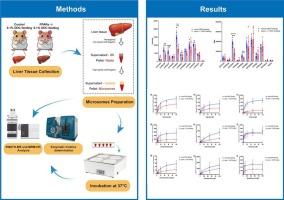The regulatory roles of pparα on hepatic drug-metabolizing enzymes in primary sclerosing cholangitis Syrian hamsters
IF 5.6
2区 医学
Q1 PHARMACOLOGY & PHARMACY
引用次数: 0
Abstract
Primary sclerosing cholangitis (PSC) is a chronic liver disease characterized by bile duct inflammation and fibrosis, ultimately leading to liver dysfunction. The role of peroxisome proliferator-activated receptor α (pparα) in regulating hepatic drug-metabolizing enzymes, including cytochrome P450s (P450s) and UDP-glucuronosyltransferases (UGTs), in PSC remains insufficiently understood. In this study, wild-type and pparα −/− Syrian hamsters were used to establish a PSC model, aiming to investigate the effects of pparα on the expression and activity of P450 and UGT enzymes. Sequential windowed acquisition of all theoretical fragment ions profiling and multiple reaction monitoring mass spectrometry with high resolution assays revealed a significant downregulation of CYP2C27 and CYP2D20 in pparα−/− hamsters. Enzymatic kinetic assays demonstrated reduced activity for several enzymes, including CYP1A2 (involved in the metabolism of acetaminophen), CYP2C family (responsible for 4′-hydroxy diclofenac formation), CYP2D family (involved in dextrorphan production), CYP2E1 (involved in 6-hydroxy chlorzoxazone production), and UGTs (responsible for chenodeoxycholic acid 24-acyl-β-D-glucuronide and mycophenolic acid glucuronide formation). These reductions suggest impaired drug metabolism and an increased risk of drug-drug interactions in conditions of reduced pparα function. In contrast, enzymes such as the CYP2B family, CYP3A family, and UGTs involved in N-Acetyl serotonin β-D-glucuronide formation retained their activity, indicating selective pathway preservation in pparα −/− hamsters. These findings highlight the selective regulatory roles of pparα on certain drug-metabolizing enzymes, providing important insights into metabolic regulation in pparα-deficient states.

ppara对原发性硬化性胆管炎叙利亚仓鼠肝脏药物代谢酶的调节作用。
原发性硬化性胆管炎(PSC)是一种以胆管炎症和纤维化为特征的慢性肝病,最终导致肝功能障碍。过氧化物酶体增殖物激活受体α (pparα)在PSC中调节肝脏药物代谢酶,包括细胞色素p450 (p450)和udp -葡萄糖醛基转移酶(UGTs)的作用尚不清楚。本研究采用野生型和pparα -/-叙利亚仓鼠建立PSC模型,探讨pparα对P450和UGT酶表达及活性的影响。序列窗口获取所有理论片段离子谱分析和高分辨率多反应监测质谱分析显示,CYP2C27和CYP2D20在pparα-/-仓鼠中显著下调。酶动力学分析表明,几种酶的活性降低,包括CYP1A2(参与对乙酰氨基酚的代谢)、CYP2C家族(负责4′-羟基双氯芬酸的形成)、CYP2D家族(参与右旋孤儿的产生)、CYP2E1(参与6-羟基氯唑酮的产生)和UGTs(负责鹅去氧胆酸24-酰基-β- d -葡萄糖醛酸和霉酚酸葡萄糖醛酸的形成)。这些减少表明,在pparα功能降低的情况下,药物代谢受损和药物相互作用的风险增加。相比之下,参与n -乙酰5 -羟色胺β- d -葡糖苷形成的CYP2B家族、CYP3A家族和ugt等酶保持了活性,表明pparα -/-仓鼠的选择性途径保留。这些发现强调了pparα对某些药物代谢酶的选择性调节作用,为pparα缺乏状态下的代谢调节提供了重要的见解。
本文章由计算机程序翻译,如有差异,请以英文原文为准。
求助全文
约1分钟内获得全文
求助全文
来源期刊

Biochemical pharmacology
医学-药学
CiteScore
10.30
自引率
1.70%
发文量
420
审稿时长
17 days
期刊介绍:
Biochemical Pharmacology publishes original research findings, Commentaries and review articles related to the elucidation of cellular and tissue function(s) at the biochemical and molecular levels, the modification of cellular phenotype(s) by genetic, transcriptional/translational or drug/compound-induced modifications, as well as the pharmacodynamics and pharmacokinetics of xenobiotics and drugs, the latter including both small molecules and biologics.
The journal''s target audience includes scientists engaged in the identification and study of the mechanisms of action of xenobiotics, biologics and drugs and in the drug discovery and development process.
All areas of cellular biology and cellular, tissue/organ and whole animal pharmacology fall within the scope of the journal. Drug classes covered include anti-infectives, anti-inflammatory agents, chemotherapeutics, cardiovascular, endocrinological, immunological, metabolic, neurological and psychiatric drugs, as well as research on drug metabolism and kinetics. While medicinal chemistry is a topic of complimentary interest, manuscripts in this area must contain sufficient biological data to characterize pharmacologically the compounds reported. Submissions describing work focused predominately on chemical synthesis and molecular modeling will not be considered for review.
While particular emphasis is placed on reporting the results of molecular and biochemical studies, research involving the use of tissue and animal models of human pathophysiology and toxicology is of interest to the extent that it helps define drug mechanisms of action, safety and efficacy.
 求助内容:
求助内容: 应助结果提醒方式:
应助结果提醒方式:


